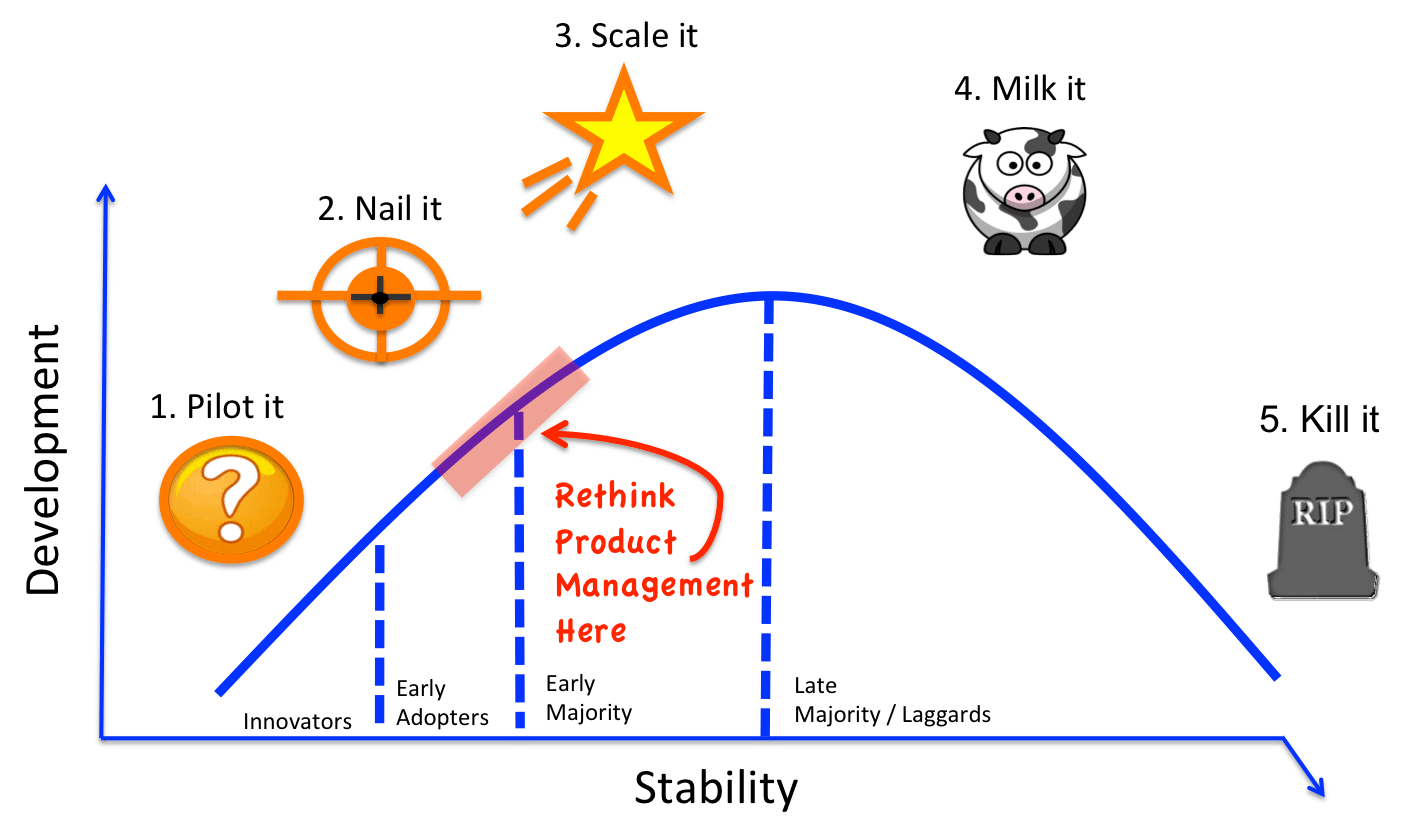Is your Product Management Designed to Scale?
Summary Insight:
If you’re stuck scaling-up, the problem isn’t your product—it’s your Product Management. Redesign this function, and execution speed, margin, and scale follow.
Key Takeaways:
- Product Management is a distinct, high-leverage function—not a side hustle for devs or marketers.
- Break it out, give it P&L, staff it right, and decentralize it close to the customer.
- Without it, your strategy stalls and your founder stays stuck in the weeds.
I earn my living as a scaling coach to expansion-stage companies. One of the advantages of my position is that I get a deep, inside look into different industries and businesses. While no two situations are exactly alike, I have seen a consistent yet under-reported issue out there that keeps 9 out of 10 companies from getting out of start-up mode to the next level.
What is it? It’s a breakdown in Product Management.
Assuming that you already have a sound strategy and execution framework in place, if you can get your Product Management function right, you’ll solve a lot of problems inherent in scaling your business. You will also have a much easier time increasing revenue growth, execution speed, agility, and profits. If you don’t get Product Management right, scaling to your potential will be much harder or even impossible.
Before proceeding, I need to call out that the problems and solutions described in this article are only applicable to a company in the late Nail It to early Scale It lifecycle stage of business development:
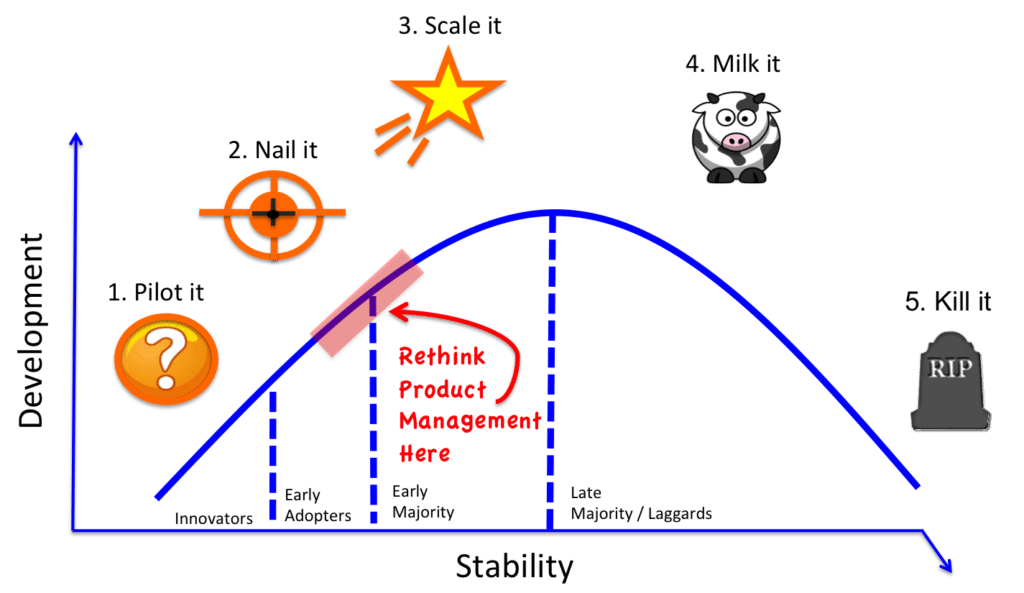
In the early start-up stages of a business, Product Management doesn’t need to be a well-defined function. It’s just something that is organically “managed” by a product-savvy entrepreneur. At this stage, there’s a drive to find product-market fit and not much else matters.
But once product-market fit is established and the company is ready to scale up by adding new product lines, customer types, or markets between the late Nail It and early Scale It stages, that’s when Product Management should be rethought and redesigned. This article will help you do just that.
Is There a Breakdown in Your Product Management Function?
It’s pretty easy to spot a breakdown in the Product Management function in your business. Assuming that your business has already aligned around a clear growth strategy and execution framework, some symptoms of a Product Management breakdown will show up when there is one or more of these conditions:
- Poor coordination between sales, engineering, manufacturing, and marketing
- Haphazard quality in new product releases
- A struggle to translate customer needs into a delightful customer experience
- Growing revenues but little or no profits
- Finger-pointing and blame between departments
- Perpetually late product development
- A strong technical product but poor product marketing or vice vera
- A lack of organizational clarity on the short- to mid-range product roadmap
- A visionary entrepreneur who is stuck managing product details
Now, you’re probably thinking that I’m attributing a lot of internal corporate issues to a breakdown in just one function. And I am. That’s because at its core, Product Management is a translation, prioritization, and coordination function. And when it breaks down, this has a big impact across the entire organization. Let’s see why…
Product Management: It’s Not What You Think
The term “Product Management” can mean many different things to different people. For example, does your own definition include product marketing? Product development? Product pricing and positioning? Feature prioritization? Product strategy? Brand management? Resource allocation? More?
If you’re trying to improve something, you must first start with a clear definition of what it is you’re working on. There are actually five primary product management-related functions that every business performs but are distinct functions that should be treated as such. These five functions are Product Strategy/Vision, Product Design, Product Development, Product Marketing, and Product Management. While the titles may be different in your own business, the core functions will be familiar to you.
Terms and Definitions: Throughout this article, I use a shorthand code called “PSIU” to refer to the four forces and styles present in any organization: Producing, Stabilizing, Innovating and Unifying. You can learn more about PSIU here and take the World’s Fastest Personality Test to get a basic sense of it before proceeding.
Product Strategy/Vision (psIu)

Product Strategy/Vision is the function that finds the breakthrough product opportunities in the marketplace: “Hmmm, what potentials exist out there that we can bring together in new and innovative ways and that allows us to fulfill on our purpose?” The Product Strategy leader asks this question all the time and has the answers (sometimes the right answers, sometimes the wrong ones, but opinionated answers nonetheless).
A head of Product Strategy is usually either really enthusiastic or really frustrated. Why? Because they live in the future with a vision for how the world should be. When their vision is tracking well and showing visible, measurable results, they are really excited, fun to be around, and charismatic. But when things aren’t tracking to their expectations, others’ don’t “get it” like they do, or they’re not in a position to effect the change they want to see, then they can come across as extremely frustrated or irritable.
The style of a head of Product Strategy is very Innovative or future-oriented and focused on possibility (psIu). “What if we tried this?” Or, “Why not do it this way instead?” A classic example of a Product Strategy/Visionary style is Elon Musk. Notice how Musk continually underestimates the true delivery time frame for all of his ventures – SpaceX, Tesla, SolarCity, etc.? That’s because the high Innovator style tends to live in the future and sees things for how they could/should be and naturally underestimates the nitty-gritty details.
In your own business, Product Strategy probably isn’t its own distinct title. Instead it’s a “hat” worn by the visionary entrepreneur, CEO, or CTO. There’s no wrong answer. It should go to the person most suited to holding, articulating and selling the vision and strategy. As you go through this next section, I’d like you to keep in mind the different skills and style needed to be a great Product Strategist/Visionary compared to the skills and style required for the other aspects of managing products.
Product Design (pSIu)

Product Design is the function that can translate the Product Strategy/Vision into an amazing customer experience. Product Design will often speak in the language of “user experience.” They’re usually asking themselves and others, “What is the purpose of this product? What is the feeling we want to create? What is the optimal design for the best user experience?” Technically, they are well-versed in key elements of the user interface and how the product can or should interact with back-end technical systems and processes.
The style of a head of Product Design is usually a mix of Innovator and Stabilizer or pSIU. This means that they excel at seeing and articulating the product vision or strategy and how it should actually show up in end-user hands. They’ll use language like “elegant, beautifully, functional, appropriate,” and also have an intense level of attention to detail when it comes to the product experience.
An example of a Product Design style is Jack Dorsey, who is co-founder and now CEO of both Twitter and Square. The media tends to define Jack as the “next Steve Jobs.” But what I want you to notice is that Dorsey’s style is more in the detail and design of the user experience rather than the classic Product Visionary style of an Elon Musk or Steve Jobs. You can see this very clearly in Apple’s history. Apple would not have been Apple without a Jonny Ives — who is a Product Designer style — to complement the Product Vision of Steve Jobs.
Depending on your business type, Product Design likely has a title of Designer (Software) or Prototype Design (Manufacturing). The titles will be different but the function the same — to translate Product Strategy into an elegantly functional user experience. The better the Product Designer holds the Product Vision, understands the back-end technology or manufacturing process, and tunes her empathy to what the end-user desires, the better she will perform in that role.
Product Development — PsIu

Product Development is the function that transforms product designs into actual working products or, in the case of a manufacturing company, actual working prototypes for manufacturing to produce at scale. The Product Developer is constantly thinking about how to translate the concept and requirements of a product design into something that actually works and getting it produced or launched — fast!
The PSIU code for a Product Development function is a high drive to Produce or get stuff out the door and a high drive to Innovate or to be creative and disrupt the status quo. Mark Zuckerberg, CEO of Facebook, is one example of a Product Development entrepreneur. Notice that he holds the product vision (Innovator) and also gets his hands dirty writing code and getting products shipped (Producer) or a PsIu style that is common to many product savvy entrepreneurs. Even after Facebook became a $1B+ business, Zuckerberg still preferred to spend most of his time head down coding on the product while others took care of the business and coordination stuff.
Depending on the type of business you’re in, Product Development may be called Software Engineering (Software), Prototype Engineering (Manufacturing). Whatever it’s called, it is valued for its ability and capacity to produce high-quality and innovative products quickly.
Product Marketing — PSIu

Product Marketing is the function that defines how the product “shows up” in the marketplace. A great Product Marketer is adept at using their intuition and data to artfully answer questions like, “What makes this product unique? Who is the core customer? What are those customers’ conscious and unconscious unmet needs? What is the pricing model? Through whom should we distribute? What campaigns will be effective?” And then driving forward the execution of the campaigns that bring that brand to life.
In PSIU code, the Product Marketing function needs a high drive to Produce results or get the volume of day-to-day work accomplished; a high drive to Stabilize or ensure that the brand is accurately presented to the world; and a high drive to Innovate or be creative (PSIu). One popular example of a classic Product Marketer is Peggy Olson from AMC’s hit TV show Mad Men. When watching the show, pay attention to the fact that Peggy works long and hard (Producing) into the night responding to client projects. She is also able to analyze and intuit the larger product strategy for breakthrough positioning (Innovating) and manage the details of the pitch with attention to detail, stability, and support (Stabilizing) to her boss Don Draper, who is a classic Creative Director type or a big Innovator.
In your own business, the Product Marketing function might be called just Marketing or Brand Management – even as it helps to manage a wide range of functions such as product positioning, pricing, promotion, competitive analysis, PR and creative, and drives marketing execution and more.
Product Management — pSiU

And this brings us to Product Management, the focus of this article. At its core, Product Management is a translation, prioritization, and coordination function. Meaning, its role is to translate “upstream” product requirements from a variety of sources including clients, sales, strategy, marketing, and R&D. It prioritizes those requirements to best meet short-range client and business needs. And it coordinates “downstream” releases so that current customers, prospects, and staff are aware of (and ideally excited by), trained on, and engaged with the evolving features and products.
This includes prioritizing Product Development and Design resources by product, coordinating with Product Marketing activities, and ensuring that the short- to mid-range product development roadmap ties into the overall Product Strategy and is clearly communicated. An outstanding Product Management function keeps the customer needs forefront in their decisions while coordinating and allocating resources to delight those customers and achieving business objectives.
In PSIU code, the Product Management function needs a high drive to Stabilize and a high drive to Unify, or pSiU for short. For instance, a classic Product Management style who is now in the public limelight is Sundar Pichai who was recently promoted to be the CEO of all of Google when it made the recent shift to its new Alphabet structure. By most accounts, Sundar is highly respected for his ability to translate the emerging products vision, manage the gap between technical product details and user experience, and coordinate across other Google functions (Stabilizer) and also to empathize and communicate with a wide range of different and often competing interests within Google to keep things moving forward (Unifier).
Aside: Note that Sundar has a very different style compared to the more famous Google co-founders, Larry Page and Sergey Brin, who both have a high Producing and Innovating style or PsIu common to entrepreneurial founders. Sundar’s pSiU style complemented Sergey and Larry’s PsIu style very well as he was able to help translate the strategy and competing product priorities into compelling Google products while navigating the political minefields and different personalities within Google. It will be interesting to see how he fares in the Google CEO role. I think he’ll do well at managing and improving on the core products Google already has while the big “moon-shot” innovations are hoped to emerge and be commercialized from elsewhere in the Alphabet portfolio. But that’s a subject for a different article.
In your own business, the Product Management function may not yet exist at all, or it may be called something different. If yours is a service or contract business, then perhaps it’s called Project Management or Program Management. Regardless of the title, the purpose of this role is to translate requirements, set short-run priorities, and coordinate releases.
In the rest of this article I’ll show why the Product Managmement function may be missing or has been set up incorrectly in a business that is attempting to scale and how to do it right. It is a very critical, high-leverage function that, when executed correctly, greatly facilitates the leap past start-up into scale-up and beyond.
Now, you may quibble with how I’ve defined and described the many facets of Product Strategy, Product Design, Product Development, Product Marketing, and Product Management, and the examples of styles found in each. It’s not an exact science and you’ll find variations in different companies and situations, along with changes in style as people evolve. But no matter how you slice it, we should all be able to agree that there’s a lot happening under the label “Product Management” that should be conceptualized as distinct and separate functions.
Put another way, if you’re waiting for some mythical combination of Elon Musk, Jack Dorsey, Mark Zuckerberg, Peggy Olson, and Sundar Pichai to materialize in your company as a single product visionary/designer/developer/marketer/manager, put the crack pipe down and come back to reality. These are different functions that must be thought of and managed differently.
So yes, you want to improve your company’s ability to define, prioritize, build, release, and promote its products – but how do you know where the breakdowns are really happening and how do you catalyze a breakthrough? Now that we have our definitions, we can start to understand what to do…
The 5 Things Every Business Can Do for Product Management Breakthroughs
 There are five basic product management tactics that every business can implement to help it scale up more easily and profitably. These five tactics are applicable to most industries and scale up situations. I’ve helped to deploy them and seen them create significant breakthroughs in revenue growth, profits, and execution speed in multiple different industries, including high tech, clean energy, healthcare, finance, services, and manufacturing.
There are five basic product management tactics that every business can implement to help it scale up more easily and profitably. These five tactics are applicable to most industries and scale up situations. I’ve helped to deploy them and seen them create significant breakthroughs in revenue growth, profits, and execution speed in multiple different industries, including high tech, clean energy, healthcare, finance, services, and manufacturing.
- Make the Product Management Role a separate function in the organizational structure
- Delegate profit & loss accountability to it
- Decentralize it so that it’s close to the customer
- Place the right style of leaders to manage it
- Equip it with sound processes, metrics, and tools
You’ll notice that all five of these tactics relate just to the Product Management function and not to Product Strategy, Design, Development, or Marketing. Why?
In most businesses struggling to scale, there’s not usually a big gap in Product Strategy, Design, Development, or Marketing. Put another way, it’s pretty easy and aligned for the current head of Marketing to manage or hire for Product Marketing; for the head of Engineering to manage or hire more Product Development or Design resources; and for the founding entrepreneur or head of the company to manage overall Product Strategy.
It’s true that sometimes early-stage start-up employees aren’t capable of scaling to the next level but, more often, it’s because they’re overwhelmed, taking on too much of the Product Management role in addition to their other roles (like when the head of Product Development or Product Marketing is also the head of Product Management). When these leaders can focus on what they’re best at, they have the time, energy, focus, and skills to thrive at the next level.
However, there usually is a breakdown in how the Product Management role is managed in a company between the Nail It and Scale It stages. Typically, the Product Management role is not treated as its own major function; it does not have P&L accountability; it is too centralized; it doesn’t have the right style or dedicated leadership; or it lacks sound processes, metrics, and tools.
And if it should turn out that your current head of Product Strategy, Design, Development, or Marketing still can’t cut it after relinquishing Product Management duties, well, congratulations. These roles are much easier to fill once you have set up these other five elements and have clarity on the real accountabilities of their respective roles. So the early focus should be on improving the Product Management function as it has been defined. Now let’s dive deeper and see how to do that.
Breakthrough #1: Make the Product Management Role a Separate Function in the Organizational Structure
Breakthrough #1 is to treat the Product Management role as its own major and separate function in the organizational structure. For instance, here’s a picture of a structure for a manufacturing company. I’ve designed it using the 5 Laws of Structure but intentionally left out the Product Management role to make a point. Note that the major business functions are in grey and each has a blue section with basic Key Performance Indicators (KPIs) to help explain its accountabilities.
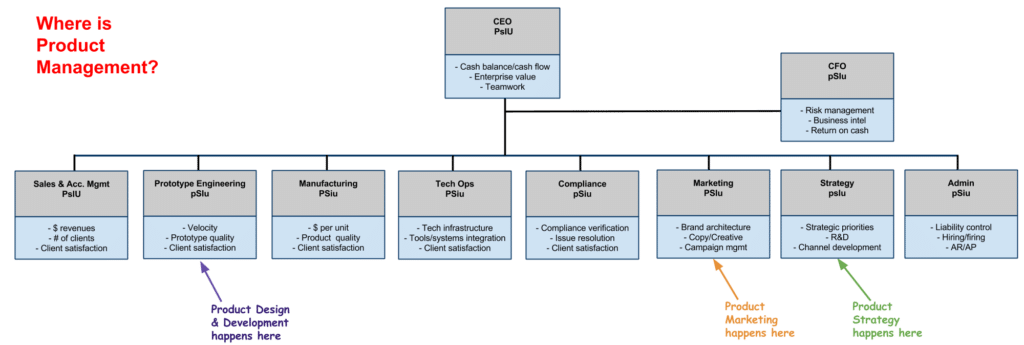
While Product Design and Development (under Prototype Engineering), Product Marketing (under Marketing), and Product Strategy (under Strategy) are in their correct relative locations in this structure, the Product Management role is missing. What do you anticipate the problems would be in a company structured like this? As the company attempts to scale, there will likely be…
- A real struggle to translate new prototypes into manufacturing efficiently
- Increasing conflict between Manufacturing and Prototype Engineering departments, with each side claiming that the other “just doesn’t get it”
- Poor communication and coordination with Product Marketing, which feels increasingly left out of the picture and unsure of what’s coming out of Manufacturing and when
- Lack of confidence across the culture that the product will do what it’s supposed to do
- A frustrated Product Strategy function because it feels that the long-range product needs aren’t being taken into consideration in product development, which is perpetually under the gun to meet short-range needs
Have you seen some of these problems before? I bet you have. When most companies run into them, they attempt to solve them by calling out for “more product management.” However, they make the mistake of assigning product management within an existing function, usually Product Development, Product Marketing, or Product Strategy. But none of these locations in the structure are ideal and, in fact, can cause a lot of harm when attempting to scale up.
The Mistake of Co-joining Product Management with Product Development or Design
 For example, what do you think happens in a business when the Product Management role and Product Development or Design roles are co-joined as the same function? That’s right, there’s a breakdown on one side or the other. If you have a technically strong head of Product Development or Design who also oversees the Product Management function, then you’ll likely have a fairly strong technical product that ends up being miscommunicated and that few are trained on. You will also have poor communication and coordination with marketing, sales, and operations on releases. Product Development seems confident in its own product and projections but everyone else isn’t.
For example, what do you think happens in a business when the Product Management role and Product Development or Design roles are co-joined as the same function? That’s right, there’s a breakdown on one side or the other. If you have a technically strong head of Product Development or Design who also oversees the Product Management function, then you’ll likely have a fairly strong technical product that ends up being miscommunicated and that few are trained on. You will also have poor communication and coordination with marketing, sales, and operations on releases. Product Development seems confident in its own product and projections but everyone else isn’t.
On the other hand, if you have a strong Product Manager who is also head of Product Development or Design, then you’ll likely have a really thorough product plan that is well-communicated but perpetually late on shipments. I.e, there is a lot of product planning being done but a lack of actual live, high-quality, working products shipped to customers on time. It should be clear that Product Development and Design roles and the Product Management role are different functions that require different accountabilities, skills, and leadership styles.
The Mistake of Co-joining Product Management with Product Marketing or Strategy
 If you co-join Product Marketing or Product Strategy with the Product Management role then the long-range functions of Product Marketing and Strategy won’t be as effective because they’ll be under constant short-range pressure to manage the current product pipeline efficiently. Product Marketing and Strategy must maintain that long-range focus to be effective while the Product Management role must have a short-range focus and deliver results efficiently. Don’t mix them.
If you co-join Product Marketing or Product Strategy with the Product Management role then the long-range functions of Product Marketing and Strategy won’t be as effective because they’ll be under constant short-range pressure to manage the current product pipeline efficiently. Product Marketing and Strategy must maintain that long-range focus to be effective while the Product Management role must have a short-range focus and deliver results efficiently. Don’t mix them.
Critically, if the Product Management role is buried under an existing function, it also won’t be able to coordinate cross-functionally very well because it’s not truly its own independent role in the structure. Let’s say that the Product Management role was buried under Marketing. If so, how do you think Sales Operations, Customer Service, and Manufacturing would view the Product Management role? That’s right, as a biased (if not useless) marketing function not pertinent to the operational demands of today. It would be given lip-service or ignored. Everyone would be frustrated with this arrangement, especially the Product Manager who wouldn’t seem to be executing on their charter.
Example of Product Management as a Separate Function in the Organizational Structure
Again, you can get away with burying the Product Management role in another function when the business is in start-up mode with fewer problems. But as you make the leap to scale-up mode and add more product lines, customer types, or markets, the Product Management role must become its own major function in the organizational structure like this:

With this approach, the Product Management role (called the ‘PM Office’ in the image above) now has its own dedicated home in the organizational structure so that it can perform its function and fulfill its accountabilities. It translates upstream requirements from clients, sales, marketing, and strategy into clear, short-range priorities. It helps to communicate and guide the transition from prototype to manufacturing. It coordinates between sales, prototype engineering, manufacturing, and marketing so that downstream product releases are well-prepared and communicated, adopted, and impactful. And critically, Product Development, Design, Marketing, and Strategy are freed up to focus on what they do best.
Breakthrough #2: Delegate Profit & Loss Accountability to It
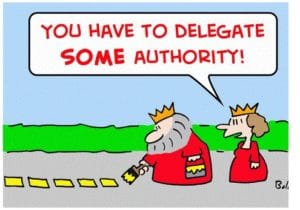 It’s not enough to just make the Product Management role a dedicated major function in the business. It should also have accountability for quarterly and annual Profit and Loss (P&L) targets for all the products and/or business units it manages. Notice in the structure above that the Product Management role is black in color? The term “in the black” means to be profitable and it is the Product Management role that should manage short-range profitability.
It’s not enough to just make the Product Management role a dedicated major function in the business. It should also have accountability for quarterly and annual Profit and Loss (P&L) targets for all the products and/or business units it manages. Notice in the structure above that the Product Management role is black in color? The term “in the black” means to be profitable and it is the Product Management role that should manage short-range profitability.
Why? One of the biggest challenges of leading a company into scale-up and beyond is freeing the founder/CEO from trying to do or manage too many things herself. What worked in a start up can become a bottleneck to growth and no longer work at scale. As a company gets into scale mode, the founder and CEO (as well as other members of the leadership team) need to start taking off the multiple hats they’ve been wearing so they can focus on fulfilling the individual roles they are best suited for.
It’s a common scenario. Imagine a fast-growing start up where the visionary founder plays the role of head of company and also wears that hats of head of Marketing, head of Product Strategy, head of Product Management, and head of Team and Culture. Obviously, this isn’t going to scale up and this founder will quickly find themselves overwhelmed, unable to delegate effectively, and a bottleneck to growth.
When there’s budget and availability, this founder must find talented replacements for each of these hats so they can focus on being the head of Company and wear just one or two additional hats (such as the head of Product Strategy or the head of Team and Culture). That’s plenty to take on at scale.
But if quarterly P&L accountability is not delegated to the Product Management role, then the founder will never fully take off the old hats. Instead, they’ll be continually sucked into making product prioritization decisions that are really in the realm and accountability of the Product Management role who needs the authority to do his job.
Accountability Should Be Matched with Authority
 Few things are more ineffective and dispiriting than having accountability for something without the authority to see it through. And the Product Management role has a lot to see through. For instance, can you get a sense for how much conflict the Product Management role must continually manage? It’s a lot. Sales has its needs. Operations has its needs. So do Strategy, Marketing, Customer Service, Finance, and others. How is all of this conflict supposed to be managed without the authority to set short-range priorities?
Few things are more ineffective and dispiriting than having accountability for something without the authority to see it through. And the Product Management role has a lot to see through. For instance, can you get a sense for how much conflict the Product Management role must continually manage? It’s a lot. Sales has its needs. Operations has its needs. So do Strategy, Marketing, Customer Service, Finance, and others. How is all of this conflict supposed to be managed without the authority to set short-range priorities?
By delegating P&L to the Product Management role, you are putting real teeth into its authority and allowing it to fulfill its purpose. It’s much more realistic for this role to make prioritization decisions based on the constraints of quarterly profit targets (whatever they may be), rather than just the strong opinion of Sales, Marketing, or Operations.
Again, the Product Management role is essential but it isn’t easy. If the team can sniff out that this position really doesn’t have the authority to make prioritization decisions, the Product Management role will be bypassed and the ensuing conflicts will end up right back at the feet of the founder/CEO. This is NOT how you get to scale.
And if you’re thinking of delegating P&L decisions to the head of Finance instead, you’re preventing the Product Management function from being responsive to customer needs and fulfilling on their charter. The head of Finance needs to support the Product Management role with clear budgets, analysis, and advice but the actual authority to make decisions within those budgets needs to reside with the head of Product Management.
How Does the Product Management Office Manage P&L In Practice?
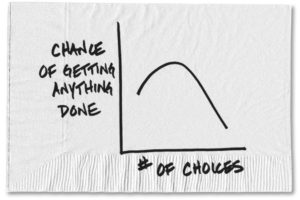 So how does the Product Management Office actually manage P&L in practice? Basically, in the budget process, the head of Company and head of Finance collaborate with the head of Sales to set annual and quarterly revenue targets and with the other functional heads to set expense budgets.
So how does the Product Management Office actually manage P&L in practice? Basically, in the budget process, the head of Company and head of Finance collaborate with the head of Sales to set annual and quarterly revenue targets and with the other functional heads to set expense budgets.
The head of Company and head of Finance then collaborate with the head of the Product Management function to set profit margin targets, the pricing matrix, and discount percentages allowed for each product. The target profit margin could be anything, even 0% as in “We’re not interested in profits right now; just step on the gas and drive revenue.”
By listening to and collaborating with all the other major business functions, Product Management decides on the resource allocations to be put toward the various products and features. For instance, in a software company, Product Management would decide what percentage of development resources to put on different products or features in a given quarter. Note that Product Management is NOT dictating which individual developers to put on different tasks. That’s the role of Product Development. Rather, Product Management is deciding what percentage of total product development resources to invest this period – as in 30% to Product A, 20% to Product B, and 50% to Refactoring, etc.
As mentioned, having accountability for P&L also allows Product Management to be effective in their role. When conflicts arise (and they will), then the quarterly P&L target is the ultimate arbitrator. For example, let’s say that Sales really wants a feature in the next release but it would mean bumping out some other critical features in the roadmap in order to deliver it. Product Management can look at all the trade-offs and say, “Listen, this isn’t personal. Here is our profit target for this quarter and next. Based on what I’m hearing from Sales, Operations, Marketing, Strategy, and Customer Service, these are the features I’m going with and why…”
Will fierce conflicts in prioritization still arise? You bet they will. And will Product Management be able to resolve all of them without help and influence from the head of Company or head of Division? Probably not. But the spirit here is really critical. If Product Management can’t resolve prioritization conflicts with their peers, then that key decision will need to roll up to the next level in the organization. But at the same time, the goal of the head of Company/Division is to push accountability for short-range prioritization decisions down to Product Management.
In a scenario where the Product Management function can’t resolve prioritization conflicts by himself or herself and the decision does end up rolling to the CEO, then a good CEO won’t just step in and decide. Instead, they’ll respond with, “Hey Sales and Product Management, if you can’t work this out together, then I will make the call – but I warn you up front, neither one of you is going to like my decision. Penelope, as head of Product Management, you have your profit targets. Sam, as head of Sales, you have your revenue targets. I’m sure you guys can find the common ground and figure out what’s best for the overall business without me having to decide. The choice is yours…”
Breakthrough #3: Decentralize It So That It’s Close to the Customer
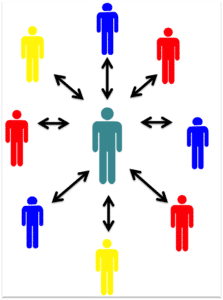
In a company that already has a well-defined Product Management role, a complaint you may be hearing around the water cooler is that the Product Management Office just doesn’t get it; that they’re too far removed to understand everyone’s needs and too heavy-handed with their decisions. If that’s the case, this is likely occurring because the Product Management role is too centralized — there’s too much riding on one person or centralized team and they can’t process through the volume of work or they are too far removed from the unique needs of a customer segment to make sound decisions.
For instance, let’s say that you are a US-based manufacturing business and have manufacturing sites in Chicago, Tokyo, and Frankfurt. Well, if you were to centralize the Product Management function in Chicago, then you can imagine the discord, complaints, and manufacturing breakdowns happening in Tokyo and Frankfurt, can’t you? Each site has its own sales team, manufacturing team, expertise, language, and culture. The solution is to decentralize the Product Manager role out to each site.

Put another way, to decentralize means that if you have multiple products, factories, or semi-autonomous sites, then a Product Management function should be assigned to each of them. That is, you’re not trying to create a bottleneck where every decision must flow to one central person or team to make Product Management decisions. Instead, you’re pushing accountability down into the organization so that those closest to the customer can conduct their own product management.
Using the above example of a manufacturing company with three sites, you’d work to develop a separate Product Management Office at each site. And each site may have multiple product managers, depending on the company size and complexity of its products and services.
Decentralizing product management has several benefits:
- You’re forming semi-autonomous teams that have revenue and profit accountability.
- The product decisions are closest to the customers they serve.
- There are no centralized bottlenecks.
When you hear this suggestion, you may be thinking that having separate Product Management offices and/or product managers seems to require a lot of new hires or a lot of overhead. Actually, no. An approach like this is a “costless structure,” meaning that you don’t have to make any new hires to make a decentralized product management structure work. If there’s not enough scale or budget to warrant a dedicated Product Management at each site, then you would simply have someone wear a part-time Product Management hat until you can afford to hire or until you need it as a dedicated position (i.e., the difference between a start-up and a scale-up).
Breakthrough #4: Place the Right Style of Leaders to Manage It
The style, vision and values, and capabilities of the people who play a Product Management role in your organization also have a lot to do with its overall success. Many struggling growth organizations make the mistake of attempting to fill their Product Management roles with a high Producer or a high Innovator style. And if you didn’t fully appreciate the true purpose of the Product Management role, then it’s easy to understand why these decisions get made.
When a High Producer is a Product Management
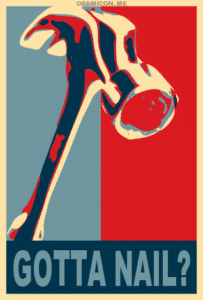 The mistake of choosing a high Producer style to lead the Product Management function usually happens because founder/CEO is frustrated by the lack of production happening in the product development domain and erroneously believes they can solve it by putting a high Producing force in the Product Management role. “We need a kick-ass go-getter who will drive the teams to get things done and won’t take no for an answer. Find me a Marine!”
The mistake of choosing a high Producer style to lead the Product Management function usually happens because founder/CEO is frustrated by the lack of production happening in the product development domain and erroneously believes they can solve it by putting a high Producing force in the Product Management role. “We need a kick-ass go-getter who will drive the teams to get things done and won’t take no for an answer. Find me a Marine!”
Clearly, every organization needs a really strong Producing force. It needs it in Sales. It needs it in Product Development. It needs it in Manufacturing and other key areas of the business. But asking the Product Management role to provide that high Producing force is like asking the guy who quickly changes tires in a NASCAR pit crew to take that same approach and manage the entire racing operation. One needs to produce lighting fast on incremental tasks and the other needs to think, orchestrate, prioritize, and coordinate across an entire team, race, and season.
It’s not only the rest of the organization that will feel frustrated by a high Producer style in the Product Management role; the Product Manager will also feel great frustration. Why? Because their daily work will feel like pushing a string. A high Producer style has a lot of energy and drive to step in and get things done but, in this new role, they can’t step in and actually get things done themselves. They need to listen, ask smart questions, empathize, coordinate, think things through, understand the details, communicate, influence, etc. All of these activities are a huge energy drain to a big Producer style but can be an energy gain to a Stabilizer/Unifier style.
When a High Innovator is a Product Management
 Another common misstep occurs when the company believes that its products aren’t creative or innovative enough and so it looks for a high Innovator style to play the Product Management role thinking that that will lead to more creative ideas. While it might create some new energy and excitement in the short run, it will come at a huge cost of poor coordination, communication, and prioritization and will slow down overall execution speed soon after.
Another common misstep occurs when the company believes that its products aren’t creative or innovative enough and so it looks for a high Innovator style to play the Product Management role thinking that that will lead to more creative ideas. While it might create some new energy and excitement in the short run, it will come at a huge cost of poor coordination, communication, and prioritization and will slow down overall execution speed soon after.
Yes, you do need innovative products. But there are already probably a ton of new breakthrough product ideas residing across your organization, including from within Sales, Marketing, Customer Service, Strategy, and R&D. Ideas that keep getting suggested but don’t get implemented. It’s not a lack of creative ideas that is holding back your product. It’s a lack of assessing those innovative ideas, prioritizing them, resourcing them, and launching them.
There is another big drawback to having a highly innovative Product Management function in a founder-led company. A talented and visionary founder is worth his or her weight in gold. They simply have an intuitive knack for understanding where the market is going, where the opportunities lie, what customers truly desire, and how to delight them. Frankly, there is no product development process that can come close to duplicating this innate sense.
But when two strong Innovating styles are forced together, this usually turns into a pissing contest over who really owns the vision. Meaning that, if there’s a high Innovating force in the Product Management role and a high Innovating force in the founder/CEO role, then the conflict over who owns the vision and sets the priorities will get severe. Soon, Product Management will be forced out or the fonder/CEO will quit in frustration.
You want Product Management to have enough Innovating force to get and appreciate breakthrough ideas coming from elsewhere in the organization. He or she especially needs to be able to translate the innovative ideas coming from the founder/CEO but also needs the strength and credibility to remain neutral and push back on their dumb ideas. They should be able to steward the product vision but not have a need to control the product vision.
The Desired Attributes of a Great Product Management
There are other capabilities and attributes to look for in a strong head of Product Management besides the natural ability to Stabilize and Unify. Some of the qualities I’ve seen that work best include:
- They are in the #1 Team Leader quadrant, meaning they not only have the skills and pSiU style; they also share the desired vision and values and aren’t mercenary.
- They have a deep technical understanding of the product. This allows them to be credible with Engineering, Marketing, Sales, Strategy, and R&D. They understand the details but without getting lost in the details.
- They command and grant mutual trust and mutual respect. A successful Product Manager doesn’t have to say a lot to get a lot done. They emanate a sense of respect for themselves and they give and receive respect with others.
- They don’t make things personal. There’s no politics, innuendo, or personal toxicity following them around like the cloud from Linus’ blanket.
- They keep the mission forefront in their decisions. They make decisions based on what’s right for the company, not what’s seen as best for an individual or department.
- They add energy to the group. They make the work fun, stay positive, and are generally additive to a group or situation. They reduce entropy; they don’t create more entropy.
In short, I want you to recognize that the Product Management role isn’t a junior role. It’s a key senior role on your leadership team. So put resources and investment into finding and filling it with the right leader, with the right structure and accountabilities, and then support it with the right processes, metrics, and tools.
Breakthrough #5: Equip It With Sound Processes, Metrics, and Tools
 There’s a booming industry of software-as-a-service (SAAS) companies that would like you to believe that if you just subscribe to their leading communication/groupware/collaboration/execution platform then your business will somehow be magically transformed. Good luck with that.
There’s a booming industry of software-as-a-service (SAAS) companies that would like you to believe that if you just subscribe to their leading communication/groupware/collaboration/execution platform then your business will somehow be magically transformed. Good luck with that.
Purchasing or deploying a new tool or platform without first making the Product Management role a core and distinct organizational function, assigning quarterly and annual P&L accountability to it, and staffing it with the right people, would be the equivalent of applying a fresh coat of paint to a badly designed house. Sure, it might look fresh for a month or two but the house is still falling apart and it’s still hard to live in it.
Instead, put most of your energy and attention into rethinking and redesigning the Product Management function (as well as your overall strategy and execution framework) and then you can help to equip the Product Management function with the right processes and tools to be effective. More specifically, strive to keep the processes and tools simple. You don’t scale through complexity; you scale through simplicity.
Regarding process, the Product Management function’s major process to manage is to define and communicate the short-range product roadmap/prioritization. The best practice I’ve seen here is for the Product Management leader to host an open product roadmap meeting once or twice a month. This means that whoever wants to influence the product roadmap can show up to that meeting and make their case. If someone doesn’t want to influence the product roadmap, then they don’t need to show up to that meeting. And if they miss that meeting, then they shouldn’t be allowed to jump in and sway those short-range prioritization decisions on the next release cycle.
The benefit of this approach is that it allows for frequent enough influence into product prioritization decisions but also enough autonomy for the Product Development team to produce actual products/features. Product prioritization decisions shouldn’t be left to the daily or weekly whim. They need some stability and focus. It also allows Product Management to have some sanity because they’re not being whipped this way and that way every day trying to accommodate an ever-changing array of feature requests.
This suggested timing is just a guideline. If you are in a setting that requires more frequent adjustments to priorities, then you may have to have that prioritization meeting every week. If not, have it every quarter. Use your best judgement.
Product Management must also make communicating the short-range product roadmap cycle a regular priority. This can be done however makes the most sense for your company, including via meeting, email, groupware, or even a dedicated product roadmap tool like ProductPlan provides (shout out to my fellow local Santa Barbarian Jim Semick!)
For metrics, also keep it simple. You don’t have to invest in a million-dollar ERP system just to figure out the exact profit margin to-the-penny of your various products. Start where you are. Guesstimates are good enough to begin. The spirit is for accountability on prioritization decisions to reside with the Product Management role and for it to have enough teeth behind its decisions to follow through and execute quickly.
As the business develops, Product Management can gain additional leverage and insight by tracking key performance indicators (KPIs) like:
- Profit margin by product
- Development time and cost by product (i.e. resource allocation)
- Customer satisfaction by product
- Sales by product
The bottom line when it comes to processes, metrics, and tools is that a strong Product Management function will likely already know what processes and tools they want to deploy and what metrics they need to track. If they try to go overboard, encourage him or her to keep it simple. Focus on having a regular and open product prioritization meeting as well as the regular communication of the short-range product roadmap and to pay attention to the metrics that really matter. That’s it.
One more thing: I would encourage Product Marketing to maintain its own product release calendar so that it can coordinate and execute on training, PR, education, campaigns, and all other aspects of product marketing. And that Product Development maintains its own development or sprint calendar too. Like an air traffic controller, the Product Management role needs to make sure the planes are doing what they’re supposed to be doing and that traffic is well coordinated, but they don’t actually fly the planes.
Also make sure to keep the product prioritization meetings SEPARATE from your regular cross-functional leadership team meetings. The product prioritization meetings are about working in the business. The cross-functional leadership team meetings are about working on the business. If you co-join these into one meeting, then you’ll spend almost all of your time deciding product prioritization and you won’t have the time energy, and focus to work on developing the rest of the business. Keep them separate.
Now that we’ve defined the terms of product management, talked through the basic scaling tactics, and answered the most pressing questions, let me share a case study with you that should help to bring it all together. This case study is based on one of my coaching client companies and I’ve changed the names to protect any proprietary information.
Case Study
Three years ago, Acme Co. was struggling to break through from Nail It to Scale It. This eight-year-old company had about $6M in annual sales but its growth had been stagnant for the past several years and it was losing money. Its main product offering was providing benefits administration services to large employers. If you can picture 10,000 employees at Honda logging into a web portal to track and update their benefits, then you have an idea of their basic business model. Acme had invested heavily in its technology platform so that it could provide personalized information and benefits education to thousands of employees at scale.
The CEO of Acme, Max Payne, is a very smart, driven visionary. He didn’t set out to be in the large employer benefits administration business but found himself there because, after several early pivots, that’s where the market demand was, albeit with increasing competition and deteriorating margins.
For the past several years, Max was anticipating that the adoption of the Health Care Affordability Act by the US Government would unleash huge market demand from large employers and insurers to track quality of care (He was right). His vision was to transform Acme into a Quality of Care and Benefits provider – one with higher margins and faster growth potential, and a lot more exciting to manage than a low-growth, low-margin, pure benefits administrator. The challenge was that the company seemed to keep tripping over its own two feet during execution.
From his own assessment at the time, Acme seemed to be struggling most with:
- A compelling and exciting vision but poor execution
- Difficulty in managing the competing needs between the existing benefits business and the new quality of care initiative
- Too many dropped balls between signing on and onboarding new clients
- Inefficient manual processes that never seemed to get fixed
- Everyone not on the same page in understanding priorities and resource allocation
- Product development taking too long on the next-generation portal
- Max spent too much time managing internally vs. being external, meeting with new clients and partners to sell the vision, win early accounts, and build momentum for the new model, which he was very well suited to do
- A lack of capital, time, and energy to do everything at once.
At the time, Acme had an organizational structure that functioned something like this:
- Product Management didn’t really exist. It was “sort of managed” by the head of Software Engineering, head of Marketing, scrum master, and Max. A common problem was that new features for the next-generation portal would get built but were usually a surprise to everyone outside of product development and weren’t communicated well to clients or to support staff.
- Product Marketing was weak. It was managed by the head of sales who also oversaw marketing. The company knew this wasn’t ideal but didn’t have the budget yet to have a full-time head of marketing.
- Product Strategy was very strong. Max had and maintained a very clear vision of what the product could do and was very skilled at communicating that vision to the entire ecosystem.
- Product Design and Development was heroic. What do I mean by heroic? They were perpetually understaffed but had a small, committed, and talented software engineering team who kept building really great technical products.
- Other major functions like Sales, Customer Support, Channel Management, Tech Ops, Finance, Accounting, and Admin did exist and were being managed well, but with the usual challenges of a growing business.
Our solution was to break out a separate Product Management function.
After adopting this new structure at first, the company didn’t have a dedicated leader to head up its newly formed Product Management Office. Instead, a temporary hat was worn by the head of Tech Ops who did his best to manage the Product Management Office in the short run while the head of Software Engineering owned Product Development and Design, the head of Sales continued to wear the hat of head of Marketing and oversaw Product Marketing, and Max continued to wear the hat of Product Strategy, which he continues to wear to this day.
Over the next three to four months the company hired a dedicated person to be the full-time Product Manager as well as a dedicated head of Marketing. Note how much easier it is to hire into a clear structure with well-defined roles. Even if your business doesn’t have a budget to make new hires, you should still create the right structure and assign temporary hats to current staff and then hire into those roles as you can afford to do so.
In this new structure, the accountabilities of the Product Management Office were to translate requirements from sales, strategy, marketing, and operations; prioritize the short to mid-range Product Development roadmap and resource allocation; and coordinate with Product Marketing on new product and new feature releases so that both internal staff and external customers and prospects are aware, educated, and trained to get the most of those features and benefits.
So what were the results of this new structure? Breaking the Product Management Office out as its own major function in the business has some profound benefits. In this case:
- The company has grown from $6M to $30M in sales in just two years (i.e. their timing was right thanks to Max’s high Innovating style and it is actually executing on its strategy thanks to the new Product Management role).
- Its net operating margin has improved from approximately 12% to over 50%.
- Max spends significantly less time managing the business and almost no time managing the product pipeline (other than contributing his desired priorities from Product Strategy).
- The business is an emerging leader in the new exciting growth field.
- The company just completed a new financing round at a significantly higher valuation.
- Intra-departmental communication and coordination has improved tremendously.
- The distinct accountabilities between Product Management, Strategy, Design, Development and Marketing are clear and managed by different leaders who are each a strong fit for their roles.
Now, just as I was attributing a lot of internal corporate breakdowns to one role — Product Management — I’m also now attributing a lot of internal breakthroughs, including increasing sales, improving product margins, better communication and coordination to that same role. Is this all really due to breaking out the Product Management Office as its own major function? Yes and no.
Yes, because Product Management was conspicuous by its absence. That is, if the organization is in scale-up mode and it is a complicated task to manage multiple product lines, customers, markets, or conflicting priorities, then the absence of Product Management will cause the business to bog down in its execution.
No, because Product Management does not operate in isolation. Every successful business must also have the basic foundation in place to scale. This includes a strong cultural system, a clear strategy, good cross-functional decision-making processes, great communication, a sound organizational structure, talented people who fit the culture, and effective targets and KPIs. In this case, Max did a great job of making sure that all the foundational pieces were alive within Acme and then by adding Product Management as its own major function into the mix, it could really scale up quickly.
Summary
Having coached over 50 multimillion-dollar companies from the Nail It to the Scale It stage, I’ve seen firsthand how Product Management can make or break your efforts to scale. In this critical stage transition, redesigning Product Management is essential.
Product Management is a distinct function from Product Strategy, Product Design, Product Development, and Product Marketing. If your business is making the leap from start-up to scale-up, then in order to be successful, you should make the Product Management role its own major function, delegate P&L accountability to it, staff it with the right leaders and team, and equip it with sound processes, metrics, and tools. Avoid Product Management bottlenecks by decentralizing the PM function to the teams closest to the customer. Finally, having a strong Product Management function does not mean you can skip the other elements of running a sound business – culture, strategy, structure, process, people, etc. The Product Management role is a catalyst that helps to bring all of those other aspects together for quick execution but it can’t itself overcome a misaligned structure or environment.
I hope you find this article helpful and that it gives you some things to think about as you work to create breakthroughs in your own organization.
